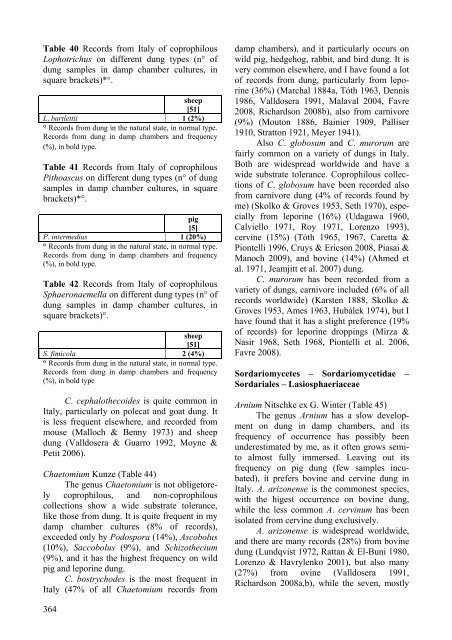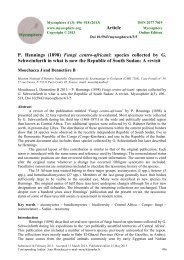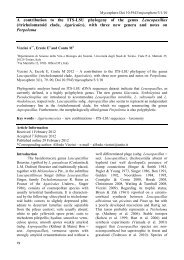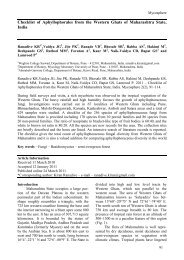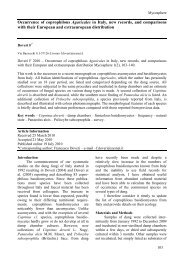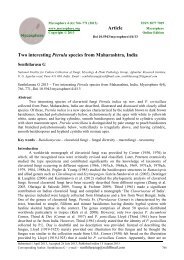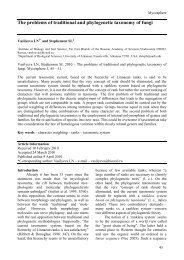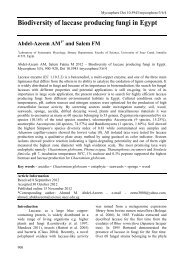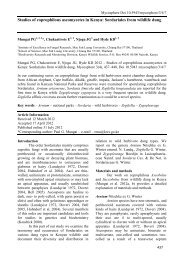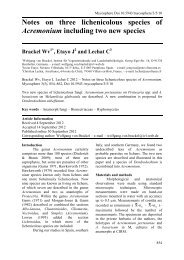Fungi Fimicoli Italici - Mycosphere-online journal
Fungi Fimicoli Italici - Mycosphere-online journal
Fungi Fimicoli Italici - Mycosphere-online journal
You also want an ePaper? Increase the reach of your titles
YUMPU automatically turns print PDFs into web optimized ePapers that Google loves.
Table 40 Records from Italy of coprophilous<br />
Lophotrichus on different dung types (n° of<br />
dung samples in damp chamber cultures, in<br />
square brackets)*°.<br />
sheep<br />
[51]<br />
L. bartlettii 1 (2%)<br />
° Records from dung in the natural state, in normal type.<br />
Records from dung in damp chambers and frequency<br />
(%), in bold type.<br />
Table 41 Records from Italy of coprophilous<br />
Pithoascus on different dung types (n° of dung<br />
samples in damp chamber cultures, in square<br />
brackets)*°.<br />
pig<br />
[5]<br />
P. intermedius 1 (20%)<br />
° Records from dung in the natural state, in normal type.<br />
Records from dung in damp chambers and frequency<br />
(%), in bold type.<br />
Table 42 Records from Italy of coprophilous<br />
Sphaeronaemella on different dung types (n° of<br />
dung samples in damp chamber cultures, in<br />
square brackets)°.<br />
sheep<br />
[51]<br />
S. fimicola 2 (4%)<br />
° Records from dung in the natural state, in normal type.<br />
Records from dung in damp chambers and frequency<br />
(%), in bold type<br />
C. cephalothecoides is quite common in<br />
Italy, particularly on polecat and goat dung. It<br />
is less frequent elsewhere, and recorded from<br />
mouse (Malloch & Benny 1973) and sheep<br />
dung (Valldosera & Guarro 1992, Moyne &<br />
Petit 2006).<br />
Chaetomium Kunze (Table 44)<br />
The genus Chaetomium is not obligetorely<br />
coprophilous, and non-coprophilous<br />
collections show a wide substrate tolerance,<br />
like those from dung. It is quite frequent in my<br />
damp chamber cultures (8% of records),<br />
exceeded only by Podospora (14%), Ascobolus<br />
(10%), Saccobolus (9%), and Schizothecium<br />
(9%), and it has the highest frequency on wild<br />
pig and leporine dung.<br />
C. bostrychodes is the most frequent in<br />
Italy (47% of all Chaetomium records from<br />
364<br />
damp chambers), and it particularly occurs on<br />
wild pig, hedgehog, rabbit, and bird dung. It is<br />
very common elsewhere, and I have found a lot<br />
of records from dung, particularly from leporine<br />
(36%) (Marchal 1884a, Tóth 1963, Dennis<br />
1986, Valldosera 1991, Malaval 2004, Favre<br />
2008, Richardson 2008b), also from carnivore<br />
(9%) (Mouton 1886, Bainier 1909, Palliser<br />
1910, Stratton 1921, Meyer 1941).<br />
Also C. globosum and C. murorum are<br />
fairly common on a variety of dungs in Italy.<br />
Both are widespread worldwide and have a<br />
wide substrate tolerance. Coprophilous collections<br />
of C. globosum have been recorded also<br />
from carnivore dung (4% of records found by<br />
me) (Skolko & Groves 1953, Seth 1970), especially<br />
from leporine (16%) (Udagawa 1960,<br />
Calviello 1971, Roy 1971, Lorenzo 1993),<br />
cervine (15%) (Tóth 1965, 1967, Caretta &<br />
Piontelli 1996, Cruys & Ericson 2008, Piasai &<br />
Manoch 2009), and bovine (14%) (Ahmed et<br />
al. 1971, Jeamjitt et al. 2007) dung.<br />
C. murorum has been recorded from a<br />
variety of dungs, carnivore included (6% of all<br />
records worldwide) (Karsten 1888, Skolko &<br />
Groves 1953, Ames 1963, Hubálek 1974), but I<br />
have found that it has a slight preference (19%<br />
of records) for leporine droppings (Mirza &<br />
Nasir 1968, Seth 1968, Piontelli et al. 2006,<br />
Favre 2008).<br />
Sordariomycetes – Sordariomycetidae –<br />
Sordariales – Lasiosphaeriaceae<br />
Arnium Nitschke ex G. Winter (Table 45)<br />
The genus Arnium has a slow development<br />
on dung in damp chambers, and its<br />
frequency of occurrence has possibly been<br />
underestimated by me, as it often grows semi-<br />
to almost fully immersed. Leaving out its<br />
frequency on pig dung (few samples incubated),<br />
it prefers bovine and cervine dung in<br />
Italy. A. arizonense is the commonest species,<br />
with the higest occurrence on bovine dung,<br />
while the less common A. cervinum has been<br />
isolated from cervine dung exclusively.<br />
A. arizonense is widespread worldwide,<br />
and there are many records (28%) from bovine<br />
dung (Lundqvist 1972, Rattan & El-Buni 1980,<br />
Lorenzo & Havrylenko 2001), but also many<br />
(27%) from ovine (Valldosera 1991,<br />
Richardson 2008a,b), while the seven, mostly


